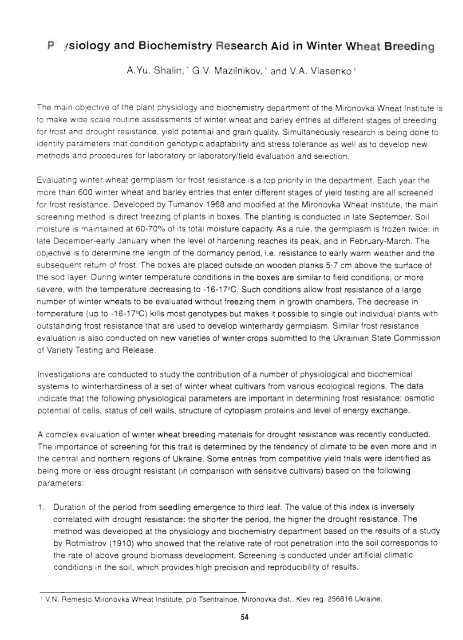Untitled - Search CIMMYT repository
Untitled - Search CIMMYT repository
Untitled - Search CIMMYT repository
You also want an ePaper? Increase the reach of your titles
YUMPU automatically turns print PDFs into web optimized ePapers that Google loves.
p' jsiology and Biochemistry Research Aid in Winter Wheat BreedingA.Yu. Shalin, 1 GV Mazilnikov, 1 and V.A. Vlasenko 1The main objective of the plant physiology and biochemistry department of the Mironovka Wheat Institute isto make wide scale routine assessments of winter wheat and barley entries at diHerent stages of breedingfor frost and drought resistance. yield potential and grain quality. Simultaneously research is being done toidentify parameters that condition genotypic adaptability and stress tolerance as well as to develop newmethods and procedures for laboratory or laboratory/field evaluation and selection.Evaluating winter wheat germplasm for frost resistance is a top priority in the department. Each year themore than 600 winter wheat and barley entries that enter diHerent stages of yield testing are all screenedfor frost resistance. Developed by Tumanov 1968 and modified at the Mironovka Wheat Institute, the mainscreening method is direct freeZing of plants in boxes. The planting is conducted in late September. Soilmoisture is maintained at 60-70% of its total moisture capacity. As a rule, the germplasm is frozen twice: inlate Decemoer-early January when the level of hardening reaches its peak, and in February-March. Theobjective is to determine the length of the dormancy period, i.e. resistance to early warm weather and thesubsequent return of frost. The boxes are placed outside on wooden planks 5-7 em above the surface ofthe sod layer. During winter temperature conditions in the boxes are similar to field conditions, or moresevere, with the temperature decreasing to -16-17°C. Such conditions allow frost resistance of a largenumber of winter wheats to be evaluated without freezing them in growth chambers. The decrease intemperature (up to -16-17°C) kills most genotypes but makes it possible to single out individual plants withoutstanding frost resistance that are used to develop winterhardy germplasm. Similar frost resistanceevaluation is also conducted on new varieties of winter crops submitted to the Ukrainian State Commissionof Variety Testing and Release.Investigations are conducted to study the contribution of a number of physiological and biochemicalsystems to winterhardiness of a set of winter wheat cultivars from various ecological regions. The dataindicate that the following physiological parameters are important in determining frost resistance: osmoticpotential of cells, status of cell walls, structure of cytoplasm proteins and level of energy exchange.A complex evaluation of winter wheat breeding materials for drought resistance was recently conducted.The importance of screening for this trait is determined by the tendency of climate to be even more arid inthe central and northern regions of Ukraine. Some entries from competitive yield trials were identified asbeing more or less drought resistant (in comparison with sensitive cultivars) based on the followingparameters:1. Duration of the period from seedling emergence to third leaf. The value of this index is inverselycorrelated with drought resistance: the shorter the period, the higher the drought resistance. Themethod was developed at the physiology and biochemistry department based on the results of a studyby Rotmistrov (1910) who showed that the relative rate of root penetration into the soil corresponds tothe rate of above ground biomass development. Screening is conducted under artificial climaticconditions in the soil, which provides high precision and reproducibility of results.IV N. Remeslo Mironovka Wheat Institute, p/o Tsentralnoe, Mironovka dist., Kiev reg. 256816 Ukraine.54

















